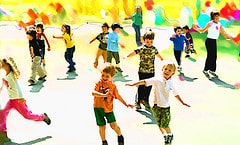When a child is diagnosed with autism, it can be devastating for the entire family.
Autism has an impact on a child’s ability to communicate with others and enjoy a normal life. In severe cases, communication can be extremely limited and it may not be possible for that individual to participate in the level of relationship with others that makes life meaningful and productive. Autistic children are, as one highly functioning autistic child put it, ‘trapped in a world of their own’. Fortunately, research is constantly improving and there is evidence that the physical exercise of running may be beneficial to children, teenagers and even adults who have been diagnosed with autism.
Increasing Rates of Autism?
In the year 2000, only one in 150 children were thought to have some form of autism spectrum disorder. Unfortunately, the rates and estimates seem to be increasing. Current estimates suggest that one in 68 children will be diagnosed somewhere on the spectrum. The data may actually represent an improvement in that less children are going undiagnosed and more are receiving the help they need. But it’s clear to some experts that cases are escalating. Fortunately however, breakthroughs in catching the condition early and quickly helping children to re-socialize are having a dramatic impact on functional limitations and the quality of life autistic children are able to achieve.
Caregivers and medical professionals are discovering new ways to improve therapy and teach children to communicate and improve their awareness of others.
Impact of Running
Although research on the impact that running has on autism is still in the early phases, there is evidence to suggest that therapeutic exercise may provide some key benefits for children with spectrum disorder.
Therapeutic exercise impacts our bodies in four main ways: it releases endorphins into the body, it improves balance and coordination, it improves overall health, and it has an impact on mood. Children run naturally as part of play, and when they do they’re obtaining new health benefits and gaining an heightened ability to focus. The discipline required for regular running also positively impacts routine. Healthy routine is known to reduce some behaviors commonly associated with autism. Running in particular also helps create an awareness of one’s surroundings.
Along with the physical benefits, therapeutic exercises such as running have an impact on focus and concentration. For instance, during and after a workout, spectrum children are showing signs of improvement in their behavior and mood. They seem happier and are less likely to act out. Tiredness is an important part of rest and brain function, and as adults, we all know that sleep comes easily and quickly after a full day of strenuous outdoor activity.
Potential Studies
The impact of physical activity and running on autism is still in the early stages of research. Medical professionals are still exploring its benefits, and plan for instance, to determine whether running has a positive impact on eye-contact and communication.
Studies are limited, but there are early signs that running may be beneficial in a number of areas. Therapeutic exercise in general is beneficial for children, teenagers and adults in improving overall health and mood, and new studies suggest that running may be useful in the treatment of autism.
Photo Credit: daystar297 via Compfight cc



